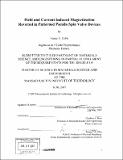Field and current induced magnetization reversal in patterned Pseudo Spin Valve devices
Author(s)
Colin, Irénée A. (Irénée Anthelme)
DownloadFull printable version (5.774Mb)
Other Contributors
Massachusetts Institute of Technology. Dept. of Materials Science and Engineering.
Advisor
Caroline A. Ross.
Terms of use
Metadata
Show full item recordAbstract
The field and current induced magnetization switchings of Pseudo-Spin-Valve (PSV) devices are described in this dissertation. An aligned sequence of three (one optical and two electron-beam) lithographies was used to define the devices and their electrical contacts. The PSV stack comprised a layer of soft ferromagnetic material Ni80oFe20 (NiFe or Py), a non-magnetic spacer layer of Cu, a hard ferromagnetic layer of Co and a capping layer of Au. The current flowed in plane (CIP) and the devices displayed giant magnetoresistance (GMR). Three different shapes were investigated: notched bars, elliptical rings and rhomboidal rings. In the bars, the notches provided strong pinning potential wells for transverse domain walls in the NiFe layer, which, upon cycling an external field, reversed in a step-like fashion, with domain walls nucleating from both ends of the bars, due to strong magnetostatic coupling between both magnetic layers. Additional important magnetostatic coupling effects were measured and micromagnetic simulations confirmed the ubiquity of such coupling. Current induced magnetic switching (CIMS) experiments were conducted, and threshold densities of the order of 1011 A/m2 were used to switch the magnetization under an external bias field, and the critical current decreased with increasing bias. (cont.) Simulations showed that the Oersted field generated by the current was sufficiently strong to switch the magnetization in the soft NiFe layer, without taking into account spin-transfer torque effects. Ring shaped devices allowed for a diversity of responses depending on the contact configurations used which may be divided into two categories: the classical configurations and the Wheatstone bridge configurations. The latter allowed for large effective GMR ratios up to 200 %, with low switching fields down to a few Oersted. Both types of contact configuration along with micromagnetic simulations enabled a deep understanding of the field-induced reversal of both elliptical and rhomboidal rings. Magnetostatic coupling effects were also found to play a key role. CIMS experiments were conducted, and the rhomboidal ring device successfully switched, in the Wheatstone bridge configuration, under zero bias with a threshold current density of the order of 1011 A/m2. The density and length of current pulses was found to change the critical current density, which suggested that the spin structure of the domain walls in the NiFe layer was modified by the current.
Description
Thesis (S.M.)--Massachusetts Institute of Technology, Dept. of Materials Science and Engineering, 2007. Includes bibliographical references.
Date issued
2007Department
Massachusetts Institute of Technology. Department of Materials Science and EngineeringPublisher
Massachusetts Institute of Technology
Keywords
Materials Science and Engineering.